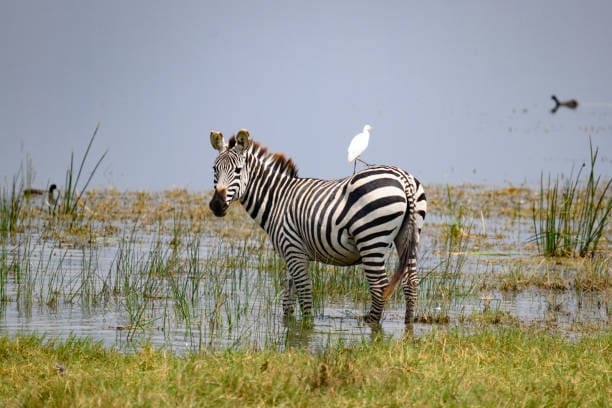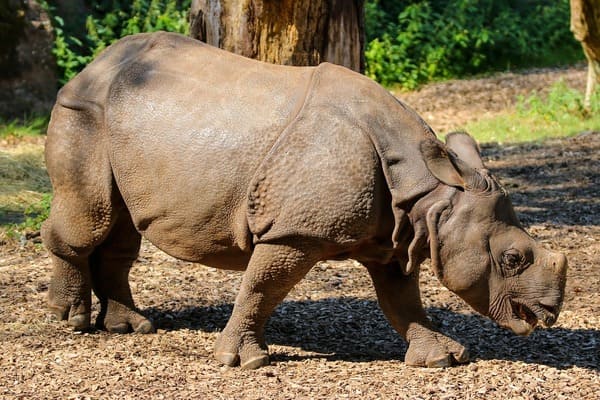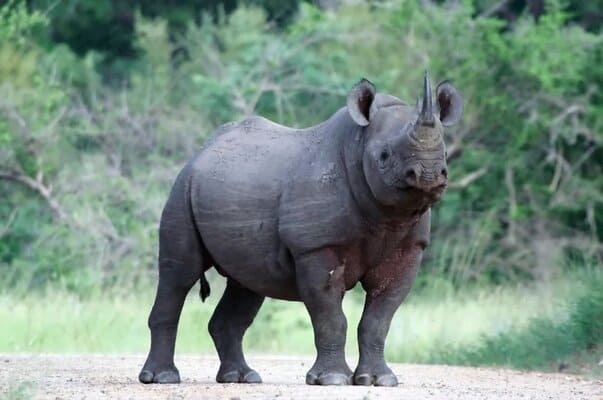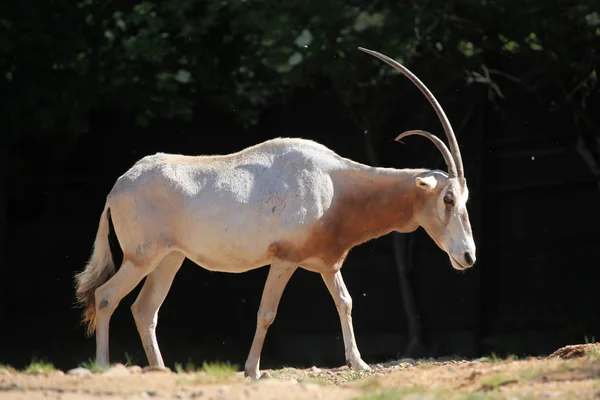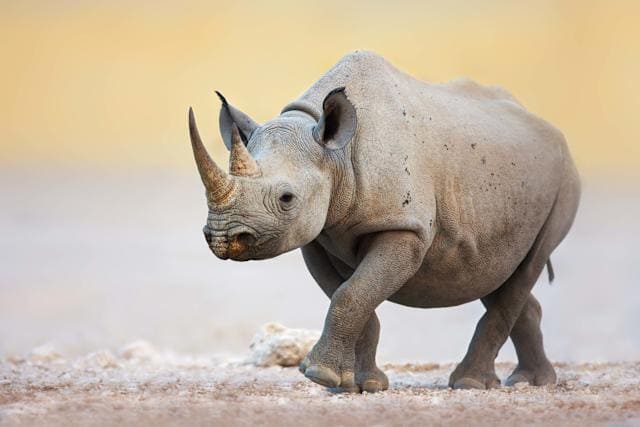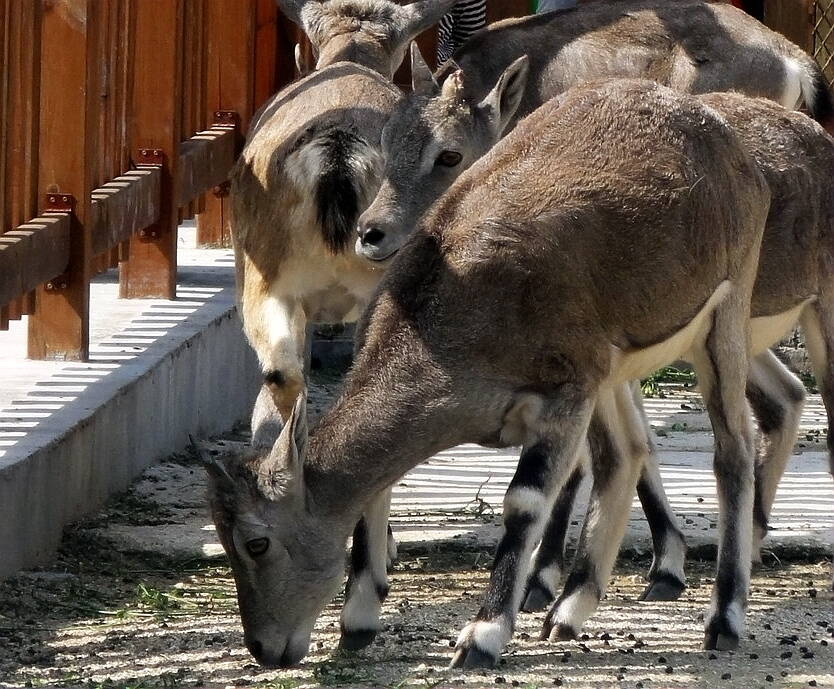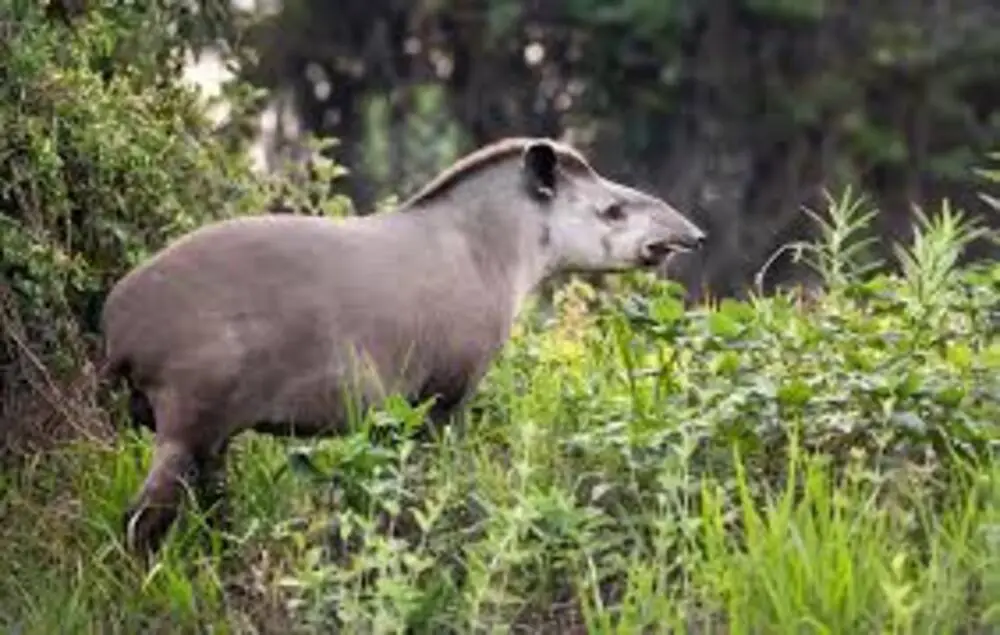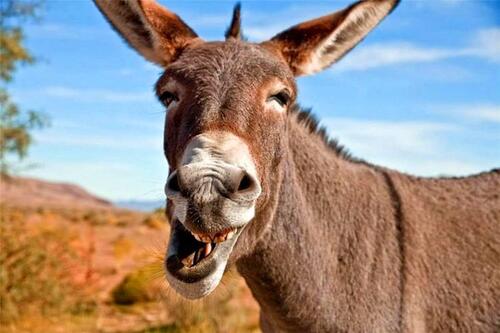Equus africanus asinus
IUCN
LCBasic Information
Scientific classification
- name:Equus africanus asinus
- Scientific Name:donkey,Equus asinus,
- Outline:Ungulata
- Family:E.a.asinus E.africanus Equus Equidae Perissodactyla Mammalia
Vital signs
- length:200~220cm
- Weight:130-260kg
- lifetime:50-60years
Feature
Body size and appearance: Donkeys are small in size, with large heads and long ears, slightly narrow chests, thin limbs, short trunks, and equal height and length, in a square shape. The hair color is mostly gray-brown, with short and sparse hair at the end of the tail.
Life habits: Donkeys are herbivorous animals that like warm and dry climates, are resistant to hunger and thirst, heat, and are afraid of severe cold. They are gentle in temperament, hardworking, and obedient to service, and can survive and work in various environments because of their strong, rough-tolerance, low risk of illness, and gentle temperament.
Behavioral characteristics: Donkeys like to lie on the ground and roll to relax their bodies after work. Female donkeys will frequently open and close their mouths and secrete mucus during estrus, while male donkeys like to raise their heads and make long calls.
Uses and value: Donkeys play an important role in agriculture and transportation. They
Distribution and Habitat
The habitat is very wide, almost all over the world. The distribution range of donkeys is very wide, covering almost many countries and regions from Africa to Asia. Specifically, the habitat of donkeys includes: Africa: Donkeys are widely distributed in Africa, including but not limited to Guanzhong, Dezhou, Jiami, Biyang, Xinjiang and other places. The climatic conditions in these areas are diverse, which are suitable for the survival and reproduction of donkeys. Asia: Donkeys are also widely distributed in Asia, from the coast in the east to Xinjiang in the west, from Jilin and Inner Mongolia in the north to the Huaihe River in the south. The climatic conditions in these areas vary, and there are traces of donkeys from warm and dry to cold areas. Qinghai-Tibet Plateau: Tibetan wild donkeys are rare animals unique to the Qinghai-Tibet Plateau and are also first-class protected wild animals in my country. They mainly live in plateaus, alpine desert grasslands, and mountain desert belts
Appearance
Donkeys are small in size, with large heads and long ears, narrow chests, thin limbs, short trunks, and equal height and length in a square shape. Their fur is mostly gray-brown, with long hair at the end of their tails.
Details
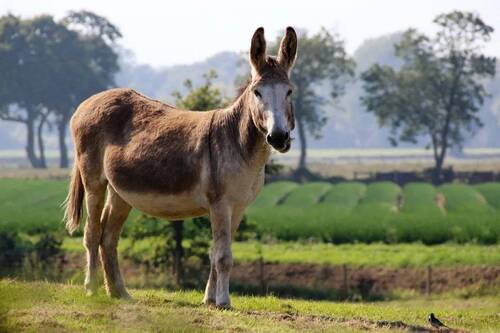
Donkey (scientific name: Equus africanus asinus, Equus asinus foreign name: donkey) alias: donkey, donkey, is a common domestic animal of the genus Equus of the family Equus, a mammal, like a horse, but smaller than a horse, with longer ears and face, a slightly narrower chest, mostly gray-brown hair, and long hair at the end of the tail. The lifespan is generally 50 to 60 years. It is mostly used as a working animal and also for military use. It is a subspecies of the African wild ass domesticated by humans. It is similar in shape to a horse, but has long ears and a tail with a caudal stalk, similar to a cow's tail.
Donkeys are members of the order Perissodactyla. Other members include zebras and horses, which have the same shape of feet and hooves. The call is loud and high-pitched and piercing. It is small in size. The head is large, the ears are long, there is no bristle, and the mane is short and sparse; the withers are low, the back is slightly raised, the waist is short and solid, and the transverse process is short and thick; the rump is short and oblique, mostly pointed and oblique, there is no long hair at the base of the tail, and the long hair at the end of the tail is short and sparse; the limbs are slender, only the forelimbs have cicadas, the hooves are small and upright, and the hooves are hard. There are four kinds of hair colors: gray, black, blue, and brown, with gray being the most common. But there is a white eye circle. Due to different breeds, the size of the body is quite different, the small one is similar to a big dog, and the big one is as tall as a horse.
Distribution area
The distribution range is wide, originating from Africa, and they can be found in many areas of Europe, Asia, Africa, North America, South America and Oceania. In China, the distribution of donkeys is closely related to the number of breeding in various places, showing obvious regional characteristics. For example, Xinjiang, Inner Mongolia, Gansu and Shandong are the main production areas of donkey breeding in China. In addition, donkeys are also distributed in Asia, Africa and other places. In China, donkeys are mainly distributed in North China, from the coast in the east to Xinjiang in the west, from Jilin and Inner Mongolia in the north to the Huaihe River in the south.
They are highly adaptable and can survive in various environments, including arid deserts, grasslands, mountainous areas, tropical and temperate regions. Donkeys are used for various purposes around the world, such as agriculture, transportation, load-bearing, viewing, and leisure. In rural areas, donkeys are used for farming, transportation, and grazing. In addition, donkeys are also used as ornamental animals in some tourist resorts and zoos.
Donkeys are herbivorous livestock that like warm and dry climates, are resistant to hunger and thirst, resistant to heat, and afraid of severe cold. They are timid and stubborn, good at walking but not good at galloping, have loud voices, and are resistant to diseases. They have a small appetite and chew finely. Feeding should be regular and quantitative, and feed less and add more frequently. Mix oats, bran or other concentrates with the feed.
They eat slowly but chew finely, which is related to their hard and developed teeth and flexible upper and lower lips, which are suitable for chewing coarse and hard feed. Donkeys have well-developed salivary glands, and 4 times the amount of saliva can soften and digest 1 kg of forage. Donkeys have small stomachs, which are only 1/15 of the same size of cattle. The cardia sphincter of the donkey's stomach is well-developed, but the vomiting nerve is not well-developed, so it is not suitable to feed feed that is easy to ferment and produce gas, so as to avoid gastric expansion. The chyme stays in the stomach for a very short time. When the stomach capacity reaches 2/3, the stomach contents are continuously discharged into the intestine with continuous feeding. The chyme in the donkey's stomach is digested in layers, so it is not suitable to drink a lot of water during feeding, so as not to break the layered state and let the incompletely digested food rush into the small intestine, which is not conducive to digestion. This requires us to feed donkeys regularly and quantitatively, and feed less and add more frequently.
The intestinal caliber of donkeys is uneven, such as the ileocecal opening and the blind knot opening are small. Improper feeding or insufficient drinking water can cause intestinal infarction and constipation. This requires us to correctly prepare forage for donkeys and provide sufficient drinking water. Under normal circumstances, chyme is decomposed by bile, pancreatic juice and intestinal juice in the small intestine, and nutrients are absorbed by the intestinal mucosa and transported to the whole body through the blood. The large intestine, especially the cecum, plays the role of the rumen of cattle, where cellulose is fermented, decomposed and digested by a large number of bacteria and microorganisms. However, since it is located in the middle and lower parts of the digestive tract, the digestion and utilization of cellulose is far less than that of the rumen of cattle and sheep.
Habits
A general term for three species of mammals in the subgenus Asinus of the genus Equus of the order Perissodactyla. There is only one species of African wild ass in Africa, which is believed to be the ancestor of the domestic donkey. Its coat color is similar to that of the domestic donkey, which is blue-gray and stained with brown. Its sound is the same as that of the domestic donkey, and its ears are long.
There are two species of Asian wild ass: the Tibetan wild ass, which is mainly distributed in the Qinghai-Tibet Plateau and Tibet; the Central Asian wild ass is produced in the Xinjiang Uygur Autonomous Region of China, the Mongolian People's Republic, near Lake Baikal in the Soviet Union, Iran, Afghanistan, Syria and the northern part of the Arabian Peninsula, and is believed to be extinct. The Asian wild ass is not a typical donkey. Its ears are shorter than those of the African wild ass, its hooves are larger, and its voice is like that of a horse. It is usually 200 to 220 cm long and about 130 cm high at the shoulder. Its hair is bright brown chestnut or reddish brown in summer and light gray in winter.
The African wild ass lives in dry areas. The Asian wild ass is drought-resistant and cold-resistant, and generally lives in deserts, steppes, and grasslands. The Tibetan wild ass is usually found in open plateaus or mountain basins at an altitude of 3,000 to 5,100 meters. It is alert and extremely agile, and likes to gather in groups. In summer, it can form a large group of more than 200 heads. It mates in autumn and gives birth in the summer of the following year, with one baby per litter. The African wild ass is an animal that is on the verge of extinction. There are still a certain number of Tibetan wild asses in Asia, and in China, they are listed as key protected animals. Crossbreeding wild asses with domestic horses can produce offspring with strong vitality, donkey-like voices, but no reproductive ability.
It likes to live in dry and warm areas, is not cold-resistant, can tolerate heat, hunger and thirst, and some can go without food for several days. The amount of water consumed is small, and the ability to resist dehydration is strong. When dehydration reaches 25% to 30% of body weight, only loss of appetite will occur, and drinking water once can make up for the lost water. Donkeys eat less, 30% to 40% less than horses. Donkeys are tolerant to roughage, and their ability to digest crude fiber is stronger than that of horses, and their digestive capacity is 30% higher than that of horses. Donkeys have strong disease resistance, and their nerve types are more balanced than those of horses, so they are not prone to digestive organ diseases.
Reproduction
The reproductive cycle has obvious seasonal characteristics and usually takes place in spring and autumn. Spring is the estrus period of donkeys, mainly between February and April. During this period, the egg quality in female donkeys is higher, and the conception rate is relatively high. Autumn is another estrus period of donkeys, from September to November. Although the conception rate in autumn is slightly lower than that in spring, the reproductive potential of female donkeys in autumn should not be ignored. The estrus cycle of female donkeys is an average of 21 days, with a range of 10 to 33 days. The estrus cycle of Guanzhong donkeys is 18 to 21 days, accounting for 71%. The average estrus cycle of a Texas donkey is 22 days. The main factors affecting the length of the estrus cycle are climate and feeding and management conditions.
The first mating about half a month after giving birth is called "blood mating", "blood mating" or "hot mating". Female donkeys do not show estrus symptoms such as "smacking mouth" and "back ears" during estrus, but rectal examination shows that follicles are developing. 5 to 7 days after giving birth, follicles will develop on the ovaries of female donkeys, and then continue to develop until ovulation, without any external estrus performance. The first ovulation time of female donkeys in Guanzhong after giving birth is mostly concentrated in 12 to 14 days after giving birth.
The estrus period of donkeys is 3 to 14 days, generally 5 to 8 days. According to the statistics of 172 estrus periods of Guanzhong donkeys, the average is 6.1 days. 80% of female donkeys are mostly concentrated in 4 to 7 days. The length of the estrus period varies with the age, nutritional status, season, temperature and the severity of the work of the female donkey. Generally, the estrus period of young, overweight, and overworked female donkeys is longer; otherwise, it is shorter. In the north where the temperature is lower, female donkeys start to estrus in February and March every year, which is the so-called "cold donkeys and hot horses". However, the estrus period in early spring is longer, and the follicles develop slowly. There are often multiple follicles and alternating development of ovarian follicles on both sides, which can last up to 20 days or longer for the elders. It usually returns to normal from April.
Age of first mating: refers to the age of first mating. After sexual maturity, the body of the donkey foal continues to develop, and it can only be bred when it reaches a certain age and weight. Premature mating will affect the development of the donkey's body. The female donkey matures at 3.5 to 5 years old, so the first mating age is 3 years old and 90% of the adult weight. Male donkeys are generally not officially used for mating until they are 4 years old.
Sexual cycle: The sexual cycle and estrus cycle of donkeys are relatively long, usually 11 to 15 days. During this period, female donkeys will show estrus behavior and physiological changes. The estrus period usually lasts 2 to 3 days.
Male insemination: The male donkey attracts the female donkey by trampling and licking with his hind legs, and then mates. During mating, the male donkey (male donkey) will transport sperm into the reproductive tract of the female donkey (female donkey) through his penis. This process usually occurs when the female donkey enters estrus.
Fertilization and conception: The sperm meets the egg in the female donkey's reproductive tract. If the egg is successfully fertilized, conception will occur. Usually, the fertilized egg after conception will move to the uterus and embed into it, starting the pregnancy process.
Pregnancy: The fertilized egg is successfully implanted in the female donkey's uterus and begins to develop into an embryo. The embryo will be pregnant in the female donkey's uterus, usually lasting about 11 to 14 months, about 320 to 370 days. During pregnancy, the female donkey will experience physiological changes such as weight gain, mammary gland development, and increased appetite to adapt to the development needs of the fetus.
Birth: Once the gestation period is over, the baby will begin to show signs of labor. Before birth, the mother donkey will usually have obvious prenatal signs, such as a sagging abdomen, a raised tail, and swollen breasts. The birth process usually lasts for a few hours, which means that the donkey is about to give birth. The mother donkey will use uterine contractions to push the baby through the reproductive tract until it is born.
Raising the foal: Once the foal is born, it will stand up and suckle the mother donkey's milk as soon as possible. During the foal's early life, the mother donkey will provide nutrition and protection for the foal, helping the foal to grow quickly. The foal is generally weaned within a few months, and the mother donkey will be responsible for raising and feeding the foal. The foal gradually grows under the care of the mother donkey until it can live independently. It is important to note that the breeding of donkeys and horses may produce mules (a hybrid of donkeys and horses), while the mating of donkeys and donkeys will produce donkey offspring. Crossbreeding between donkeys and horses is a relatively common situation in producing mule offspring.
A male donkey can mate with a female horse, and the offspring is called a mule. A mule is large, has the load-bearing and resistance of a donkey, and the flexibility and running ability of a horse. It is a very good draft animal, but it is basically infertile, and only a few can give birth.
If a male horse and a female donkey mate, the offspring is called a donkey mule. Donkey mules are small and generally not as good as horse mules, but they can sometimes give birth.
Donkeys mature early. Male donkeys reach sexual maturity at 1 year old and female donkeys reach sexual maturity at 1-1.5 years old. Growth and development stop at 3 years old. They are in estrus in spring and autumn. The estrus cycle is about 23 days and the estrus lasts for 5-6 days. The gestation period is about 360 days. They can reproduce until they are over 20 years old.
The donkey's fetus grows and develops quickly. The height of the newborn can reach more than 62% of that of an adult donkey, and the weight can reach 10% to 12% of that of an adult donkey. Donkeys reach sexual maturity early, at 1.5 to 2 years old. The reproduction rate is also higher than that of horses. Female donkeys can produce more than 10 foals in their lifetime.
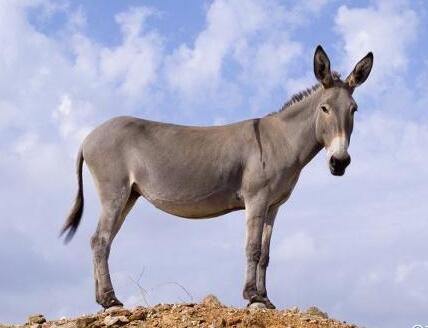
Uses
Animal power
Donkeys are more adaptable than horses, can tolerate rough food and heavy loads, and are cheaper than horses. Therefore, they have always been an important working animal for humans. Some young donkeys can carry quite tall people. Generally, a donkey can carry up to 100 kilograms of weight, and can walk for five to six hours on a mountain road without any problems. It is widely used in the agricultural field and can help people with farming, carrying goods and transportation. Donkeys are very alert to danger, so they will not listen to people's drive in some dangerous situations, and appear to be quite stubborn, the so-called "donkey temper". But in general, they have a gentle temper, and can also be a loyal companion of humans during travel and play.
There are more than 30 varieties of donkeys in China, among which the fine varieties are produced in Shandong Province. Guanzhong donkey, Dezhou donkey, Jiami donkey, Biyang donkey, Guangling donkey, Hexi donkey and other famous donkeys weigh 250-290 kilograms, are 1.1-1.3 meters tall, can pull a load of 250-350 kilograms, and travel 30-50 kilometers a day. They are good helpers for short-distance transportation, pulling carts, carrying goods, plowing fields, and grinding rice and flour in rural areas, especially in mountainous, semi-mountainous and hilly areas.
Edible
Donkey meat has health functions such as replenishing blood, replenishing qi and replenishing deficiency. It is edible and even delicious, and it is described as dragon meat in the sky and donkey meat in the ground. The trend of eating donkey meat has also emerged in Guangdong, Guangxi, Shaanxi, Beijing, Tianjin, Hebei, Shandong and other places. There is a famous snack "donkey meat fire" in Baoding, Hebei, China, which is made by adding cooked donkey meat to baked bread. Donkey intestines are also a famous dish. Han Zhen of the Northern Song Dynasty loved to eat donkey intestines. He would use donkey intestines to cook every time he had a banquet, and they had to be killed and cooked immediately. A guest got up to go to the toilet and passed by the kitchen. He saw the tragic scene of a live donkey being cut open and its intestines were pulled out. He couldn't bear it and never ate donkey meat again for the rest of his life. When Zhu Zai, Emperor Muzong of the Ming Dynasty, was Prince Yu, he loved to eat donkey intestines. After he ascended the throne, he was quite frugal. He heard that Guanglu Temple had to kill a donkey every day, so he stopped eating it. In the Qing Dynasty, there was a way of eating "pouring donkey meat", which was to pour boiling water on the donkey's body, then shave off the donkey's hair and cut the donkey meat alive; this way of eating was gradually eliminated because it was too cruel. Donkey leather is flexible and thick, which can be used for leather making and has medicinal value. Chinese medicine also uses refined donkey skin as a medicinal material. Dong'e Ejiao is a precious Chinese medicine raw material. China kills about four million donkeys every year for this medicinal material, resulting in a sharp decline in the number of donkeys in China. Some African countries have even turned their attention to donkeys far away in Africa, forcing some African countries to ban the export of donkeys to China.
Breeding method
Donkey breeding is an integral part of traditional animal husbandry. It is transforming from providing auxiliary power for agriculture to producing meat and leather. It is rapidly developing from small-scale low profits to medium-scale high profits.
Meat donkeys have strong disease resistance, high survival rate, and wide adaptability to natural ecology. This allows the majority of meat donkey breeders to reduce costs and open up a larger profit space. Meat donkeys have fewer diseases than mules, horses, cattle, and sheep. In particular, gastrointestinal diseases are less than horses. Generally, as long as immunization is done well and the donkey pen is kept clean and dry, suitable light, ventilation and stocking density are maintained, meat donkey feed is provided, and sufficient clean drinking water is guaranteed. Meat donkeys rarely get sick. The fertilization rate and foaling rate of meat donkeys are both 90%. The foaling rate and breeding rate reach 95%. Meat donkeys have a wide adaptability to natural ecology, are heat-resistant and thirst-resistant, drink less water, and have poor cold resistance. They are more distributed in dry and hot areas. They are not suitable for living in high-altitude mountainous areas and severely cold and humid areas. The areas of western Shandong, southeastern Shandong, and northern Shandong are very suitable for raising meat donkeys. China's vast rural areas can also raise meat donkeys on a large scale. They are gentle and like to live in groups. They can be raised in orchards and hillsides or in pens, and can be fed with ordinary feed plus grass. Generally, grass accounts for about 80% of the feed. Small grains are their concentrated feed. Small grain straw is their roughage. It is also suitable for factory breeding. If you need to speed up their growth rate, you can feed them with compound feed or complete pellet feed.
Selecting suitable meat donkey varieties based on local breeding environment and market demand is the key to investing in this project. The quality of meat donkeys is directly related to fattening benefits and future development. Chinese donkeys are divided into three categories according to their size: large donkeys, medium donkeys, and small donkeys. Medium donkeys are suitable for donkey breeding, followed by large donkeys. Small donkeys are mostly used to make donkey gelatin. Their meat can also be put on the market.
Donkey milk is also very valuable. Donkey milk is very similar to human milk, and the proportion of nutrients in it accounts for almost 99% of the ingredients contained in human milk. It is the best substitute for human milk; and donkey milk has the function of moisturizing the skin and improving the facial environment.
Feeding stage
Fattening of adult donkeys
1. For newly purchased donkeys, only water is given on the first day; water is given on the second day, and grass or hay is added; water is given on the third day, grass or hay is freely eaten, and 0.5 kg of wheat bran is added; the same is true for the fourth to sixth days, and 1 kg of corn is added.
2. After a 6-day transition period, the donkeys can enter the fattening period, and they can freely eat roughage such as cereal straw, cottonseed husks, soybean straw, and corn straw. Each donkey is fed 3.5 kg to 4 kg of mixed concentrate per day, which is composed of 50% cottonseed cake or soybean meal, peanut cake, 29% cornmeal, 20% wheat bran, and 1% salt. In addition, each donkey is fed 20 grams of sodium bicarbonate per day.
3. During the fattening period, exercise should be restricted, clean drinking water should be provided, the donkey's body should be brushed every day, and the pen and surrounding environment should be kept dry and hygienic. The donkeys can be slaughtered after 60 to 70 days of fattening.
Fattening of young donkeys
1. The purchased donkeys are first dewormed, not castrated, and are raised in separate troughs according to gender and weight.
2. Newborn donkeys eat colostrum for 6 days, breastfeed after 7 days, and are trained to eat porridge made from equal parts of corn, wheat, and millet at 15 days old, with a little sugar added to induce them to eat, and are fed 10 to 20 grams per day. 3. After 22 days of age, feed 80-100 grams of mixed concentrate, the formula is: soybean meal plus cottonseed cake 50%, cornmeal 29%, wheat bran 20%, salt 1%, 100-200 grams per day for each donkey at 1 month old, 500-1000 grams per day for 2 months old, 3.5 kg per day after 9 months old, and a total of 500 kg of concentrate is consumed for fattening. If the cotton seeds are fried yellow or cooked until they expand and crack, each donkey is fed 1 kg per day, and the fattening effect is better.
4. Roughage is free to eat, and cereal straw, soybean straw, peanut seedlings, sweet potato vines, silage corn with ears, and high-quality forage grass are selected, and they must be cut short.
5. Feed 4 times a day, morning, noon, evening, and night. The proverb "Horses cannot get fat without night grass", and the same is true for donkeys, emphasizing the need to mix night grass for feeding. The proverb "Grass, fat, feed, strength, water, spirit", means that eating more grass can grow fat.
6. When feeding, pay attention to feeding less and adding more frequently, mixing the four corners, drinking enough clean water, and adding salt in moderation.
7. Every group of 20 to 25 donkeys, free movement, free consumption of roughage, free drinking of water, and free consumption of salt.
8. Brush the donkey's body every day, remove feces and urine, and clean the feeding trough.
Donkey foal care
When the donkey foal is born, the mucus and dirt on the lips and nostrils should be wiped off immediately, and then the umbilical cord should be cut. There are two methods of cutting the umbilical cord: manual cutting and ligation cutting. (I) Manual cutting is now more commonly used. This method of cutting the umbilical cord dries quickly and is not easy to get infected. The method is: hold the umbilical cord with one hand 3 to 4 fingers close to the abdomen of the newborn donkey foal, and pinch the umbilical cord of the newborn donkey foal with the other hand and stroke it towards the fetus a few times to make the blood in the umbilical cord flow into the body of the newborn donkey foal. After the umbilical vein pulsation stops, pinch off the umbilical cord with your fingers at a distance of 3 fingers from the abdominal wall, and then use a 5% iodine tincture cotton ball to fully disinfect the remaining end of the umbilical cord remaining on the abdominal wall. No bandage is required. But use 5% iodine tincture to disinfect 1 to 2 times every 7 to 8 hours. Only when the umbilical cord bleeding is difficult to stop, use a sterile rope to tie it. Whether tied or not, it must be thoroughly disinfected with iodine tincture.
(II) Titration and umbilical cord cutting is to tie the umbilical cord with sterile cotton thread 3 to 5 cm away from the abdominal wall of the newborn foal, and then cut it and disinfect it. In this method, the umbilical cord end is tied and dries slowly, and due to poor disinfection, it is easy to get infected and inflamed. Therefore, the bare-handed umbilical cord cutting method should be used as much as possible. After giving birth, the mother donkey does not lick the mucus on the foal's body like cows and horses. The midwife can use a soft cloth or towel to wipe the mucus on the foal's body to prevent the foal from catching cold. After the foal stands up, it should be allowed to eat colostrum as soon as possible, which is conducive to the elimination of meconium and the prevention of constipation.
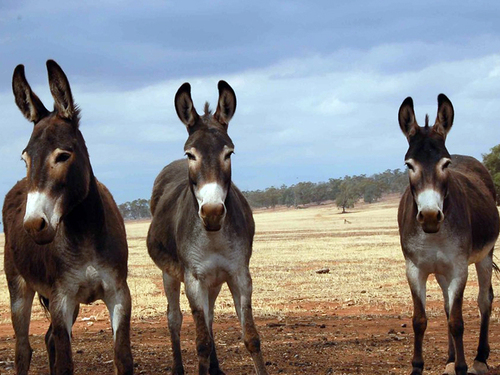
Breed introduction
China has a vast territory, and the domestication of donkeys is earlier than that of horses and mules, so donkey breeding has a long history. Donkeys can be divided into three types according to their size: large, medium and small. The five excellent donkey breeds in China are Guanzhong donkey, Dezhou donkey, Guangling donkey, Biyang donkey and Xinjiang donkey. Large donkeys are mainly distributed in the central plains and hilly areas with developed agriculture and excellent feed conditions, such as Guanzhong donkey, Qingyang donkey, Dezhou donkey and Jinnan donkey; medium-sized donkeys include Biyang donkey, which is between 110-130 cm tall; small donkeys mainly include Xinjiang donkey of arid desert ecological type, Liangzhou donkey of arid semi-desert ecological type, Xiji donkey of loess hilly gully area, rolling sand donkey of alpine sand ecological type, Northeast donkey of plain ecological type, and Southwest donkey of plateau mountainous type. They are mostly distributed in North China, Gansu, Xinjiang, Yunnan and other places. The height of donkeys in these areas is between 85-110 cm.
Small
North China donkey
It is a small donkey. Main production area: North China donkey is mainly produced in the east of the Loess Plateau in northern Shaanxi, within the Great Wall to the Huanghuaihai Plain, and distributed in the three northeastern provinces. It is a type of small donkey. Environmental conditions: There are plateaus, mountains, hills and plains in the production area. Although there are differences in topography and climatic conditions, they are all major grain and cash crop production areas in northern China, with rich feed sources, developed agriculture and animal husbandry, and environmental conditions are very suitable for the life characteristics of donkeys. North China donkey is the second largest draft animal in northern China's agricultural areas after cattle. Due to poor agricultural conditions, low crop yields, and low livestock breeding levels, small donkeys are mostly raised. In recent decades, in order to meet production needs, some areas with poor agricultural production conditions but good livestock conditions, such as Yimeng Mountain Area, Taihang Yanshan Mountain Area, Yulin Area in northern Shaanxi, Zhangjiakou Area, Zhaomeng Kulun Banner and Huaibei, have played their local advantages and developed commercial donkey production. Except for self-use, most of them are sold through famous livestock trading markets such as Datong, Zhangjiakou, Jinan, Weifang, Jieshou, and Zhoukou, and distributed to various places. Although these donkeys have their own local names, such as the rolling sand donkey in Shaanxi, the Kulun donkey in Inner Mongolia, the Taihang donkey in Hebei, the small donkey in Shandong, and the gray donkey in Huaibei. But the physical appearance is basically the same, the hair color is mostly gray, and the genetics are stable, so they are collectively called North China donkeys. Body shape and appearance: Donkeys in different places have their own characteristics due to different production areas, but their common points are: body height is less than 110 cm, slightly larger in plains, less in mountainous areas, and weighing 130 to 170 kg. Good structure, short body, slightly larger abdomen, and rough coat. The rolling sand donkey is 107 cm tall and weighs 140 to 190 kg; the Taihang donkey is 102.4 cm, the Kulun donkey in Inner Mongolia is 110 cm tall, and the donkeys in Yimeng, northern Jiangsu, and Huaibei are 108 cm. Production performance: Male donkeys reach sexual maturity at 18 to 24 months of age, and female donkeys reach sexual maturity at 12 to 18 months of age. Female donkeys start mating at 2.5 years of age and male donkeys at 3 to 3.5 years of age. The estrus season is mostly concentrated in spring and autumn, with an estrus cycle of 21 to 28 days and a duration of 5 to 6 days. The breeding period of male and female donkeys is generally 13 to 15 years, and female donkeys produce 8 to 10 foals in their lifetime.
The North China donkey is small in size, highly adaptable, large in number, and widely distributed. In order to meet the needs of animal husbandry commodity production, its body structure should be improved through breeding, and its precocity and meat production performance should be improved. In summary, the number of Chinese donkeys is large, the distribution is wide, and under the influence of long-term natural selection and artificial selection, several varieties with significant differences in body size, appearance structure and production performance have been formed. However, in the past, during the period of small peasant economy, donkeys were mainly selected for their riding, pulling and carrying performance, while in animal husbandry commodity production, we need to improve the meat production performance of donkeys. Therefore, on the one hand, it is necessary to strengthen the breeding of meat donkey breeds, and on the other hand, donkey producers should use hybrid advantages to improve the growth rate and meat performance of donkeys and develop large-scale breeding through hybridization between different breeds, especially hybridization between large breeds such as Guanzhong donkeys and Dezhou donkeys and local small and medium-sized donkey breeds.
Southwest donkey
It belongs to a small donkey. Main production areas: including Yunnan donkeys in various parts of Yunnan Province, Sichuan donkeys in Ganzi, Aba, Liangshan and other places in Sichuan, and Tibetan donkeys in Shigatse, Shannan and other places in Tibet. Environmental conditions: Yunnan, Sichuan and Tibet are mostly plateau mountainous areas and hilly areas with high altitudes, many rivers, large temperature differences, obvious dry and wet seasons, and relatively developed agriculture in the production areas. The main crops are rice, wheat, broad beans, peas, sweet potatoes, and rapeseed. Tibet is more abundant in highland barley. Crop straw and wild grass are the main forage, and beans and wheat are the main concentrates. But more than 1,000 years ago, when donkeys were first introduced, for a long period of time, most donkey-producing areas were mountainous. The soil is barren and the vegetation is sparse. The donkeys are raised and managed in a rough manner. They graze in the wild during the day and are fed with straw at night. Only a small amount of concentrated feed is given during heavy work and pregnancy, thus forming a dwarf donkey breed. Appearance: The head is heavy, the forehead is wide and high, and the ears are large and long; the topknot is low, the chest is shallow and narrow, the back and waist are short and straight, the rump is short and oblique, and the abdomen is slightly larger; the forelimbs are straight, the hind limbs are slightly outward, and the hooves are small and sharp; the coat is thick and dense, the hair is mainly gray, and there are eagle wings, light back and tiger stripes; the other parts are reddish brown. Production performance: Yunnan donkeys mature early and can be bred at the age of 2 to 3. Generally, they have two litters in three years. If they are specially raised as meat donkeys, they can have one litter in one year. The slaughter rate is 45% to 50%, the net meat rate is 30% to 34%, and the net meat weight per head is about 35 kg.
Xinjiang Donkey
Appearance and shape: The donkey is short, dry and strong, with a slightly larger head, erect ears, wide forehead, short nose, and short hair inside the ear shell; thin neck, flat back and short waist, short and slanted rump, insufficient chest width and depth, and flat ribs; short limbs, dry and strong joints, small and hard hooves; hair is mostly gray and black. Production performance: Xinjiang donkeys have sexual desire at the age of 1 year old, male donkeys are 2 to 3 years old, and female donkeys are 2 years old. Malnutrition and miscarriage rarely occur under extensive feeding and heavy labor. The survival rate of foals is over 90%. The 150th Regiment of the 8th Agricultural Division of the Xinjiang Production and Construction Corps once introduced Guanzhong donkeys and hybridized with local small donkeys. The height of their offspring reached 120 to 125 cm. The height of the improved donkey in Turpan can reach 125 to 130 cm. Therefore, large donkey breeds can be introduced to hybridize and improve Xinjiang donkeys, which can improve the body size and weight of local donkeys, and is an important way to increase meat yield in meat donkey breeding. It is a small donkey. Main production areas: Mainly produced in Kashgar and Hotan areas in southern Xinjiang. Distributed in the Gansu-Henan Corridor, agricultural areas, semi-agricultural and semi-pastoral areas in Qinghai, and Guyuan and Xiji areas in Ningxia, where it is called Xiji donkey. In Wuwei, Zhangye and Jiuquan in the Hexi Corridor of Gansu, it is called Liangzhou donkey. In addition, it is also distributed in various counties in northern Xinjiang. Environmental conditions: Xinjiang has a continental climate. Due to the influence of high mountains and deserts, the temperature is high and dry in summer. The desert is directly exposed to sunlight and the temperature can reach 55℃. There are many winds and sands, and the temperature difference between day and night is large, which is the so-called "wearing fur coats in the morning and yarn in the afternoon, holding a stove and eating watermelon". The frost-free period is short, the precipitation is small, there are large areas of grassland pastoral areas, and there are also developed agricultural areas with oases. Due to the relationship between climate and water sources, crop yields are low. Due to the poor social and economic conditions in history, farmers relied on raising donkeys for farming, carrying and riding. It can be said that donkeys are distributed wherever people live. Appearance: Xinjiang donkeys are short, dry and strong, with slightly larger heads, erect ears, wide foreheads, short noses, and short hair inside the ear shells; thin necks, low and flat topknots, flat backs and short waists, short and oblique rump, insufficient chest width and depth, and flat ribs; short limbs, dry and strong joints, small and hard hooves; mostly gray and black hair.
Medium
Qingyang donkey
Main production areas: Qingyang, Ningxian, Zhengning, Zhenyuan, Heshui, Huachi in eastern Gansu Province and Wuqi and Dingbian in Shaanxi, with Qingyang County as the central production area.
Environmental conditions: The production area is located in the Loess Plateau in eastern Gansu, with an altitude of 1,000 to 1,700 meters, in the upper reaches of the Jing River, close to the Guanzhong Plain in Shaanxi, with an average annual temperature of 9 to 10.5℃, a frost-free period of 120 to 180 days, and an annual precipitation of 300 to 500 mm. The soil is fertile, the climate is mild, and agriculture is developed. It is known as the "granary of eastern Gansu". Due to the inconvenient transportation in this area, farmers had low economic income in the past, and they mostly raised cattle and donkeys for work. For many years, they mainly raised small donkeys. After continuously introducing large donkeys from Guanzhong for hybridization and improvement, the size of local small donkeys has increased significantly, and their appearance has also changed. In addition, they adapt to the local environment and are carefully managed. The forage is mainly wheat straw and grain straw. Only a small amount of concentrated feed is supplemented during the busy farming season, and they are quite resistant to roughage. Hybrid donkeys have been bred and cultivated in their own groups for a long time, forming today's local fine breed Qingyang donkey.
Appearance: Stout and strong, body length slightly larger than body height, well-proportioned structure, medium-sized head, not too long ears, hypertrophic neck muscles, short and sparse mane, well-developed chest, large abdomen, straight limbs, obvious joints, moderate and solid hooves, gentle temperament, flexible movements, and the coat color is mainly three-powder donkeys, with a small amount of blue and gray. Qingyang donkeys are medium-sized donkeys.
Huaiyang Donkey
Main production area: southeastern Henan Plain on both sides of Shahe River and its tributaries, namely Huaiyang, western Dancheng, northwest Shenqiu, northern Xiangcheng and Shangshui, eastern Xihua, southern Taikang and Zhoukou City, with Huaiyang County as the central production area. Environmental conditions: The production area is 50 meters above sea level, with a warm tropical monsoon climate, 216 days of frost-free period, and an average annual temperature of 14.6℃. The soil is mostly silt and two-combination soil, and the soil is fertile. It is rich in wheat and grains. It has been a "granary" for dynasties. Donkeys are the main draft animals in the local area. The local area has attached great importance to the breeding of donkeys a long time ago. There are abundant agricultural and sideline products, and it is accustomed to growing alfalfa. Donkeys are often fed with various beans, with a daily feed of 1 to 1.5 kilograms, so the nutritional needs of donkeys can be guaranteed and the breeding results can be consolidated. The production area is close to livestock distribution centers such as Zhoukou and Jieshou, and often exports breeding donkeys, which stimulates donkey production and breeding. In the past 30 years, Huaiyang County has further strengthened breeding work and carried out good breed registration in key donkey production areas. Strengthening breeding selection and mating, the quality of meat donkeys has also improved significantly, and it is a local excellent donkey breed. Appearance: It is a medium-sized donkey, with a body height slightly greater than the body length, a wide body, a slightly heavy head, and a wide shoulder. It has a high withers, a well-developed forequarters, a short middle body, a barrel shape, thick and strong limbs, and a large tail. Reddish-brown donkeys are also characterized by a larger body, high withers, a single spine, a single back, and tall limbs. The hair is mainly pink and black, with less gray, less pure black, and the least reddish brown.
Biyang donkey
It is a medium-sized donkey. Main production areas: Biyang, Tanghe, Sheqi, Fangcheng, Nanyang and other cities and counties in the southwest of Henan Province, with Biyang and Tanghe counties as the central production areas. Environmental conditions: Biyang County is located between the Funiu Mountains and the Tongbai Mountains. The altitude is 810 to 983 meters. The local four seasons are distinct, with an average annual temperature of 14.613, a frost-free period of 212 days, and an average annual rainfall of 920.5 mm. It belongs to the warm temperate climate. The land is fertile and suitable for farming. Agricultural and animal husbandry production is developed, and wheat and various grains are produced in abundance. Grazing on river beaches and hills is used as the main feed for donkeys, and there are abundant forage resources. The local people have the habit of raising donkeys, feeding them carefully and paying attention to the selection and selection of breeds. There are many donkey breeding professionals who use selected good breeds for breeding, so a good breed production area has been formed. As early as 1957, the Biyang County Donkey Breeding Farm was established. Excellent individuals and excellent core groups were selected on the spot to carry out systematic breeding work, which rapidly improved the quality of the donkey herd. Appearance: Male donkeys are powerful and female donkeys are docile. Medium size, square or high square. The structure is compact and well-proportioned, smart and handsome, with full muscles, and most of them have double spines and double backs. The back and waist are straight, the head is dry and handsome, and the mouth is square; the ears are moderately large, with a tuft of white hair in the middle of the ear; the head and neck are well connected, the waist is short and strong, the rump is high, wide and slanted, the limbs are straight, the ligaments are short and upright, and the hooves are solid. The main color of the coat is three pinks.
Jiami Donkey
Also called Suimi Donkey, it is a medium-sized donkey. Main production area: It is mainly produced in Jiaxian, Mizhi and Suide counties in Shaanxi Province, with the central production area in the adjacent area of the three counties. It is distributed in nearby counties and Linxian County in Shanxi Province, as well as surrounding provinces and Yan'an and Yulin City. Environmental conditions: The production area is located in the gully area of the Loess Plateau in northern Shaanxi Province, forming the characteristics of undulating ridges, gullies, scattered land, and rugged and narrow roads. The altitude is 715 to 1350 meters, with a large temperature difference and an average annual sunshine of 2617 to 2741 hours. It is windy in spring, hot in summer and cold in winter, and has a typical continental climate. It is dry and rainy, with an average annual precipitation of 430 to 450 mm and a frost-free period of only 150 to 180 days. It is suitable for growing miscellaneous grains and a large amount of alfalfa. Crops are rotated to improve the soil and provide forage. Since the Eastern Han Dynasty, farmers have been accustomed to raising donkeys for various tasks such as plowing, pulling, carrying and riding. They are usually fed in sheds, with beans, wheat, sorghum, corn, straw and wheat straw as the main food, and green alfalfa as the feed in summer. There are some traditional donkey breeders in each county, who select fine breeds and undertake breeding work. After long-term cultivation, this local fine breed has been formed. Appearance: The Jami donkey is of medium size, slightly square, strong, well-proportioned, with large and bright eyes and thin and upright ears; the neck and shoulders are well connected, the back and waist are straight, the limbs are straight, the joints are strong, the tendons are obvious, and the hooves are solid. The male donkey has a thick neck, a wide chest, and is full of power. The female donkey has a slightly larger abdomen and a well-developed hindquarters. The hair is pink and black, and due to the different sizes of the white part, it is divided into two types. One is black swallow skin, with the whole body covered like a swallow, only the mouth, nostrils, around the eyes and abdomen are white; the other is black four eyebrows, in addition to the characteristics of black swallow skin, the white area under the abdomen is larger, and even extends to the inside of the limbs, the chest, the forehead and the roots of the ears.
Yunnan donkey
Appearance: heavy head, broad forehead, long and large ears; shallow and narrow chest, short and straight back and waist, short and oblique rump, slightly large abdomen; straight forelimbs, slightly outward hind limbs, small and sharp hooves; thick and dense fur, mainly gray, with eagle wings, shallow back, tiger stripes; other parts are reddish brown. Production performance: Yunnan donkeys mature early, can be bred at 2 to 3 years old, usually 2 litters in 3 years, if specially raised as meat donkeys, can also be 1 litter per year, slaughter rate 45% to 50%, net meat rate 30% to 34%, net meat weight of about 35 kg per head.
Large
Guangling donkey
Appearance: tall physique, strong bones, strong physique, symmetrical structure, strong cold resistance. The donkey has a large head, a straight nose, big eyes, erect ears, a thick neck, a broad and straight back, a broad chest, a wide and short rump, a thick and long tail, strong limbs, obvious tendons, well-developed joints, long tubular bones, small and round hooves, hard texture, and dense and coarse fur. The fur is black, but the eye circles, mouth, chest and the inside of the ears are pink and white. The local people call it "five whites and one black", also known as black eyebrows. There are also those with mixed black and white fur and five white features, which the people call "blue black". Both of these fur colors are superior. Production performance: Its reproductive performance is similar to that of other varieties, but it is mostly in estrus from February to September, and the estrus season is from March to May. It can produce 10 foals in its lifetime. After slaughter, the average slaughter rate is 45.15% and the net meat rate is 30.6%. It has good breeding value and has been promoted to 13 provinces and regions across the country. It is famous for its cold resistance and has good adaptation to the climate in Heilongjiang Province. It is a large donkey. Main production area: The production area is Guangling and Lingqiu counties in the northeast of Shanxi Province, distributed in the marginal areas of Guangling, Lingqiu and surrounding counties. Environmental conditions: The territory is mountainous and undulating, with a small part of the river valley basin, with an altitude of 700~2300 meters. Located in the mountainous area outside the Great Wall, it is windy and sandy, with large differences in climate change. The annual average temperature is 6.2~7.9C, the annual precipitation is 420~500 mm, and the frost-free period is 130-150 days. It is the main grain production area outside the Great Wall. The region has always attached great importance to the development of animal husbandry. Farmers raise donkeys for farming. It is the breeding base of commercial donkeys outside the Great Wall in China. Because millet and beans were abundant at that time, and alfalfa was planted, farmers carefully fed them with millet grass, black beans and alfalfa grass, paid attention to the selection of varieties, combined with service and grazing, and formed the characteristics of Guangling donkeys with tall body and strong body.
Jinnan donkey
The body is rectangular and the appearance is delicate and delicate, which is different from other donkey species. The head is elegant, of moderate size, with a broad and thick neck, a straight back and waist, a slightly high and slanted rump, slender limbs, obvious joints, distinct tendons, and pocket-shaped cicadas on the forelimbs. The tail is slender, like an ox's tail. The skin is thin and fine, with black with three whites as the main fur color, and there is also a gray big donkey. The body is beautiful, delicate and strong, and it is an excellent large local breed in China. Main production areas: Produced in Yuncheng City in southern Shanxi and southern Linfen City, with Xia County and Wenxi County as the central production areas, including Pinglu, Ruicheng, Yongji, Linyi and other counties and cities and counties in southern Linfen. Environmental conditions: The production area is located in the Loess Plateau, bordering the Yellow River. There are plains, hills and mountains, and the terrain is complex. The altitude is 400 to 1,500 meters, the terrain is high in the northeast and low in the southwest, the land is fertile, the climate is mild, the annual average temperature is 12-1413, the annual precipitation is about 500 mm, and the frost-free period is 180 to 210 days. Xia County is the hometown of Yu. The county has a long history of humanities and farming, and has developed agriculture. It is a famous grain and cotton producing area in Shanxi and rich in coal. Local farmers like to raise donkeys as a means of farming and transportation. Donkeys are fed carefully and properly, and are kept in stalls all year round to make full use of agricultural and sideline products, and alfalfa is also planted. Alfalfa is added in summer and wheat bran in winter, and fresh alfalfa is mixed with wheat straw to ensure that donkeys and other livestock can get green foal all year round. Attaching importance to seed selection and breeding of young foals has promoted the formation of this variety and exported a large number of high-quality donkeys to other places. Body shape and appearance: rectangular body shape, compact physique, delicate and delicate appearance, which is different from other donkey species. The head is delicate, of moderate size, with a broad and high neck, a slightly low topknot, a straight back and waist, a slightly high and slanted rump, slender limbs, obvious joints, distinct tendons, and pocket-shaped appendages on the forelimbs.
Texas donkey
Appearance: tall, well-proportioned, square, with good head, neck and trunk structure. Male donkeys have wide forequarters, high head and neck, big eyes and even mouth, and are powerful. They have straight backs and waists, slightly slanted rump, round ribs, strong limbs, obvious joints, and round and hard hooves. The coat color is divided into three powders (white around the nose, white around the eyes, and white under the abdomen) and black (black hair all over the body). Its body height is generally 128-130 cm, and the tallest can reach 155 cm.
Production performance: fast growth and development, sexual maturity at 12-15 months of age, and breeding begins at 2.5 years old. Female donkeys generally have regular estrus and can produce about 10 foals in their lifetime. Good donkeys at the age of 25 can still produce foals; male donkeys have strong sexual desire. Under normal circumstances, the ejaculation volume is 70 ml, sometimes up to 180 ml, and the semen quality is good. As a meat donkey, the slaughter rate can reach 53%, and the meat yield is relatively high. It is an excellent paternal breed for the improvement of small donkeys.
Guanzhong Donkey
Appearance: Guanzhong donkeys are tall, well-proportioned, and slightly rectangular in shape. They have high head and neck, large and bright eyes, broad forechest, well-opened ribs, short and oblique rump, and beautiful body shape. More than 90% of them are black hair, and a few are chestnut and blue hair. Production performance: Under normal feeding conditions, young donkeys grow and develop very quickly. At 1.5 years old, they can reach 93.4% of the height of adult donkeys and show sexual maturity. At the age of 3, both male and female donkeys can be bred. Male donkeys have the strongest breeding ability at the age of 4 to 12, and female donkeys can produce 5 to 8 litters in their lifetime. For many years, Guanzhong donkeys have been an important paternal donkey breed for the improvement of small donkeys. In particular, it has played a major role in the formation of the Qingyang donkey breed.
Origin and natural conditions of the origin: Guanzhong donkeys are large donkey breeds. They have a long history of formation and are excellent local breeds in China. It is mainly distributed in the Guanzhong Plain of Shaanxi Province and the southern part of Yan'an City, with Xingping, Liquan, Qianxian, Wugong, Xianyang, Pucheng and Lintong as the central production areas. It has been exported to North Korea, Vietnam and other countries. The Guanzhong Plain is known as the "800-li Qinchuan". The soil is fertile and the climate is mild. The annual average temperature is 12-1413, the annual sunshine is 1980-2400 hours, the annual precipitation is 540-750 mm, and the frost-free period is 190-210 days. The irrigation conditions are good, the agriculture is developed, and it is rich in grain and cotton. There are abundant agricultural and sideline products, and there is also the habit of planting alfalfa, soybeans, and peas for livestock. It is well-known throughout the country for its big cattle (Qinchuan cattle) and big donkeys. Since the Western Han Dynasty, donkeys have been an important draft animal in the region. The people have rich experience in raising donkeys and attach great importance to scientific selection and matching. Especially for male donkeys, the requirements are that the coat is pure, the black and white lines are clear, the body is tall, the structure is symmetrical, the testicles are large and symmetrical, full of power, the four hooves are straight, the hooves are large and round, and the call is loud. Therefore, after a long period of selection and breeding, the quality of this breed has been continuously improved. Body shape and appearance: Guanzhong donkeys are tall, well-proportioned, and slightly rectangular. The head and neck are high, the eyes are large and bright, the chest is broad, the ribs are well opened, the rump is short and oblique, and the body is beautiful. More than 90% of them are black hair, and a few are chestnut and blue hair. Production performance: According to measurements, the average slaughter rate of old and eliminated donkeys is 52.7%, and the net meat rate is 39%.

